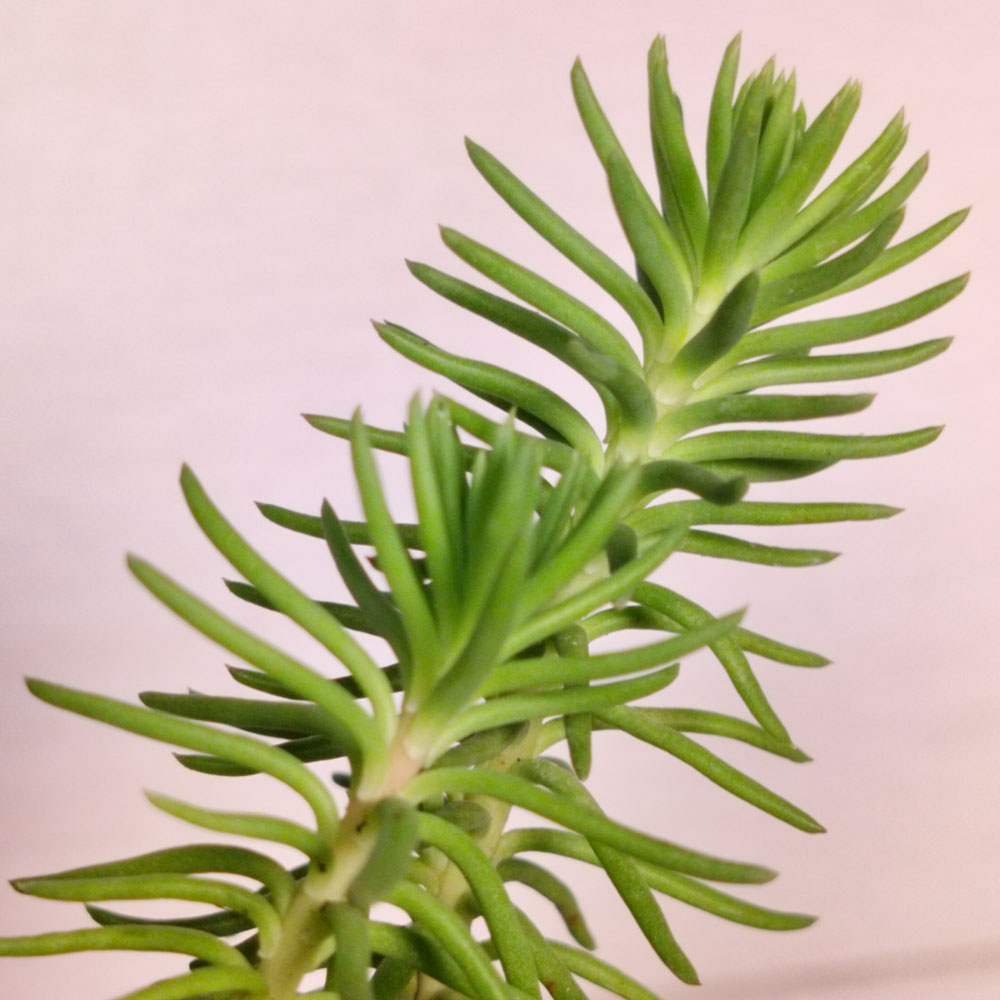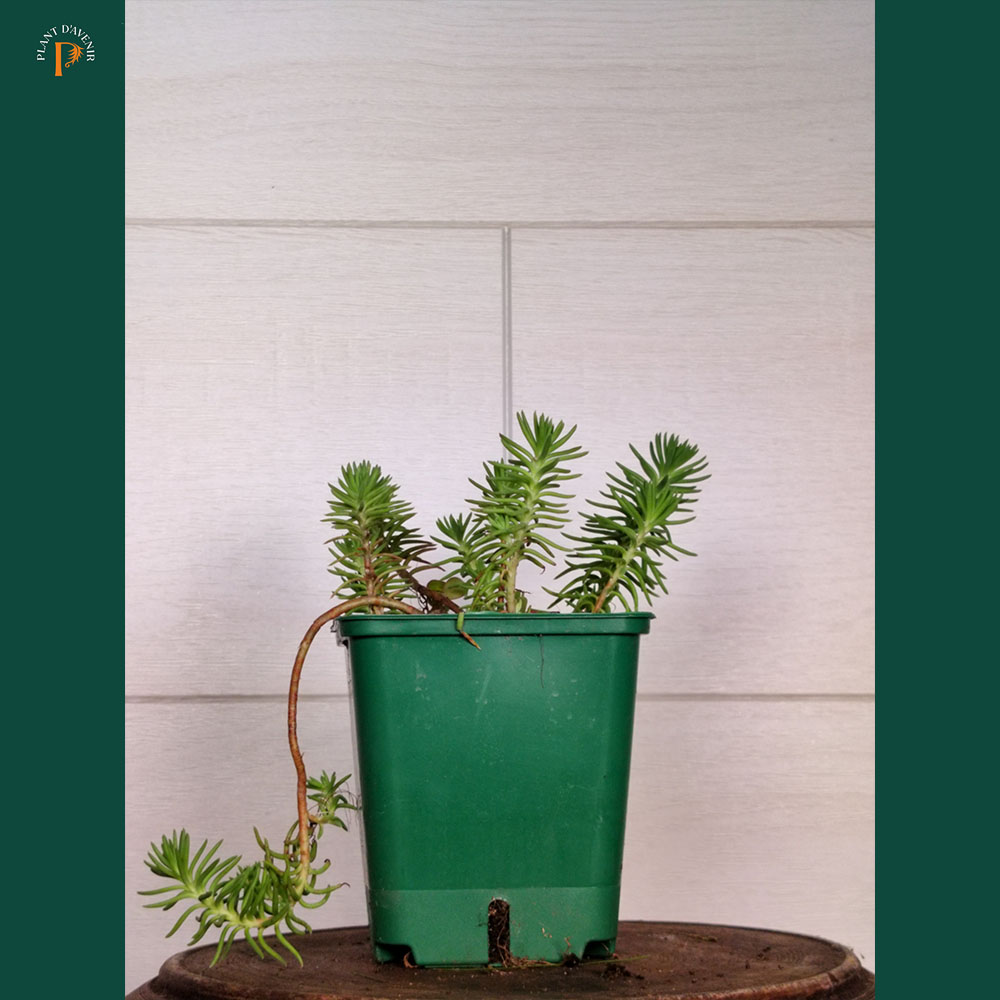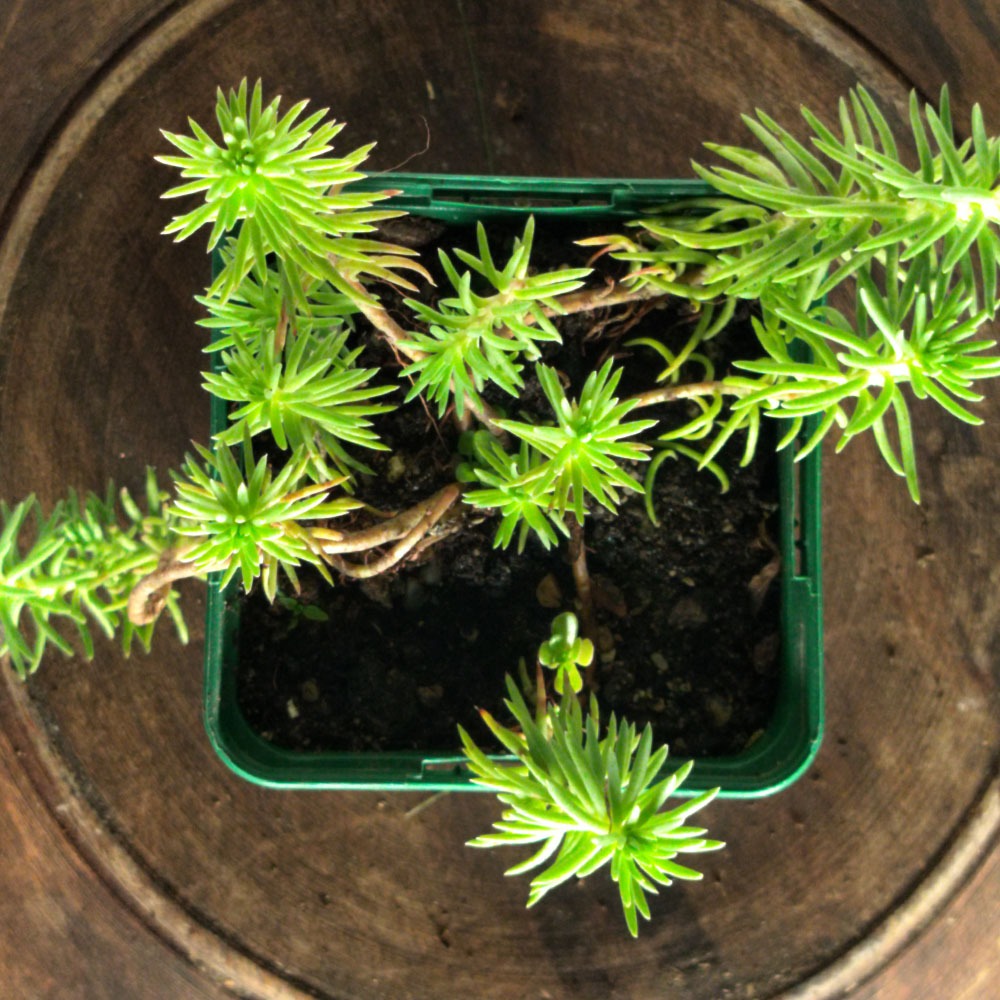No products in the cart.
Sedum rupestre
A blue grey succulent in the Crassulae family with stiff foliage resembling little spruce trees.
Rated 0 out of 5
0 customer reviews
4,90 €
Only 29 item(s) left in stock!
Tags: couvre sol, evergreen, feuillage persistant, graphique, secheresse, soleil, toits vegetalisés, vivace, xeriscaping
SKU: pda249
Category: Balcony-Friendly, Better Indoors, Bouquet, Evergreen, Frost Hardy, Ground Cover

Sedum rupestre
4,90 €
Only 29 item(s) left in stock!
Sedum rupestre is a low growing succulent, valued for its trailing stems and needle-like leaves, which can range from green to bluish-gray, often with yellowish or reddish tips under sun exposure or cold stress.
The leaves are frequently blue-gray to gray but can range to light greens and yellows; the flowers are yellow.
Like many Sedum species, it has a prostrate, spreading habit.
But it still requires little coddling and enjoys an independent lifestyle.
In a windowsill, in a pot or even in your garden – allow this little perennial to bring some light and texture.
👨🌾GARDENING TIPS👨🌾:
-
-
Perfect for rock gardens, alpine gardens, container planting, hanging baskets, or mixed succulent displays.
-
Combines beautifully with other Sedum species, Sempervivum, and Crassula for textured succulent arrangements.
-
Minimal maintenance is required, with occasional pruning to maintain shape and remove spent flower stems.
-
Learn more about caring for your Sedum:
The Tales & The Botany: Sedum rupestre
This sedum is prone to fasciation (cristate forms), which can produce attractive forms, with irregular curves and strange shapes.
However it reverts easily, so all normal offshoots need to be removed quickly to maintain the cristate form!
If you have not encountered fasciation in the world of plants before, then you must at least read about it.
A starter phrase: it’s a relatively rare condition of abnormal growth in which the apical meristem (growing tip), which normally is concentrated around a single point becomes elongated in the direction of the growth.
Translated into literary speech: the flowers or stems will stretch into long deformations of themselves, producing incredible and bizarre shapes. It looks like you stepped into a hall of mirrors at a circus.
Fasciation is fascinating.
—–
Reflexum vs rupestre – this is an ongoing debate that turns around the inflorescences and which way they face when the buds are produced.
However!
I’ve found in my Sedum journeys – both practical and literary that:
-
- the fine-leaved Sedum rupestre of Dillenius later was classified as Sedum reflexum, then reclassified by Linnaeus as Sedum rupestre var. reflexum named under Linnaeus so… they are.. the same?
- Petrosedum rupestre and Petrosedum forsterianum seem to be clearly derive from the same rupestre taxon but are systematically separated by taxonomists
It’s a bit of a wacky world.
I have found this illustration to be helpful – by Juan Luis Castillo in “Flora iberica” of Castroviejo.

The plant can be seen on ‘green roofs’ or ‘green wall’ systems in Korea where plants are incorporated into the structure of the building, providing habitats for wildlife and innovative insulation solution for humans.
🌸 Floral Morphology: Sedum rupestre
Sedum reflexum a low-growing, mat-forming succulent in the Crassulaceae family, with slender, needle-like, glaucous blue-green leaves arranged along trailing stems.
In summer, the plant produces small, star-shaped, yellow flowers clustered in loose inflorescences (cymes).
Flowers are actinomorphic and hermaphroditic, with five sepals and five petals, and a superior ovary.
The fleshy, water-storing leaves give the plant its resilience under drought and help maintain turgor during dry periods.
🧬 Reproductive Biology
Pollination is primarily entomophilous, attracting bees and other small insects. Sedum propagates easily through leaf cuttings or stem offsets, allowing rapid vegetative reproduction.
Seeds are produced in small capsules but vegetative propagation is far more common in cultivation.
The plant exhibits Crassulacean Acid Metabolism (CAM), opening stomata at night to conserve water while allowing photosynthesis during the day.
🦋 Ecology & Cultivation
Sedum thrive in well-drained, sandy or rocky soils under full sun, although it tolerates light shade.
It is drought-tolerant, frost-sensitive, and well-suited for rock gardens, containers, or as ground cover.
The plant is low-maintenance, requires minimal watering, and benefits from occasional pruning to remove damaged or overgrown stems.
Its vibrant leaf colors and compact growth habit make it popular for ornamental gardening and succulent collections.
Other names:
Petrosedum rupestre
Jenny’s stonecrop
Blue stonecrop
Stone orpine,
Prick-madam
Trip-madam
Origin:
Northern, Central, and Southern Europe.
| Weight | 0,5 kg |
|---|---|
| Flowering | June, July |
| Soil | Dry/Rocky |
| Exposure | Full Sun |
| Frost Tolerance | -25°C to -30°C |
| Size | 0.2m H x 0.5m W |
Reviews
0
Rated 0 out of 5
0 customer reviews
5
0
4
0
3
0
2
0
1
0
Only logged in customers who have purchased this product may leave a review.
Related Products
Hellebore argutifolius
Winter flowering perennial with marbled blue-green leaves
Winter flowering perennial with marbled blue-green leaves
Rated 0 out of 5
Delosperma cooperi
A dwarf perennial known for its vermillion colored flowers
A dwarf perennial known for its vermillion colored flowers
Rated 0 out of 5
Melissa officinalis
A perennial plant in the mint family that is adored by bees, royal families and tea drinkers.
A perennial plant in the mint family that is adored by bees, royal families and tea drinkers.
Rated 0 out of 5
Artemisia Valerie Finnis
A semi-evergreen, aromatic variation on the theme of Artemisia.
A semi-evergreen, aromatic variation on the theme of Artemisia.
Rated 0 out of 5
Hieracium maculatum Leopard
A native perennial with blue-green leaves and a tall yellow flower
A native perennial with blue-green leaves and a tall yellow flower
Rated 0 out of 5
Tradescantia Blushing Bride
Gorgeous blushes of pink and white that appear in the coldest nights.
Gorgeous blushes of pink and white that appear in the coldest nights.
Rated 0 out of 5
Mentha x piperita ‘Chartreuse’
A spicy mint, known for its use in the production of liqueurs and herbal teas.
A spicy mint, known for its use in the production of liqueurs and herbal teas.
Rated 0 out of 5
Tanacetum densum subsp amani
A shrublet composed of soft, finely divided silvery gray-white leaves.
A shrublet composed of soft, finely divided silvery gray-white leaves.
Rated 0 out of 5
Echinacea purpurea
A perennial with purple flowers all summer long
A perennial with purple flowers all summer long
Rated 0 out of 5
Stachys byzantina
Silky white-grey leaves and tall striking flowers
Silky white-grey leaves and tall striking flowers
Rated 0 out of 5
Vinca minor
Looping elegance and ability to form a low flowering ground cover
Looping elegance and ability to form a low flowering ground cover
Rated 0 out of 5
Trachelospermum asiaticum ‘Ogon Nishiki’
Jasmine with colorful foliage and lovely white flowers in summer
Jasmine with colorful foliage and lovely white flowers in summer
Rated 0 out of 5
Kalanchoe daigremontiana
A toothy succulent from Madagascar, known as the Mother of Thousands.
A toothy succulent from Madagascar, known as the Mother of Thousands.
Rated 0 out of 5
Euphorbia cyparissias Clarice Howard
A Euphorbia that resembles a soft little cyprus tree
A Euphorbia that resembles a soft little cyprus tree
Rated 0 out of 5
Erigeron kavinskianus
A daisy-like carpet of flowers
A daisy-like carpet of flowers
Rated 0 out of 5
Sedum album
A low, multi-color ground cover.
A low, multi-color ground cover.
Rated 0 out of 5
Euphorbia myrsinites
Known for its draping form of silver-gray foliage and radiant blooms.
Known for its draping form of silver-gray foliage and radiant blooms.
Rated 0 out of 5
Cerastium tomentosum var. columnae
A grey-green spreading ground cover from the mountains.
A grey-green spreading ground cover from the mountains.
Rated 0 out of 5
recent view product
Sedum “Weihenstephaner Gold”
A low-growing sedum with a thick, dependable dark-bronze/green foliage and prolific flowering cycle.
A low-growing sedum with a thick, dependable dark-bronze/green foliage and prolific flowering cycle.
Rated 0 out of 5
Lavandula stoechas
A highly aromatic, velvet-leaved, drought resistant, flowering perennial.
A highly aromatic, velvet-leaved, drought resistant, flowering perennial.
Rated 0 out of 5
Chrysanthemum Dernier Soleil
A perennial with large yellow flowers tipped with coppery-orange hues
A perennial with large yellow flowers tipped with coppery-orange hues
Rated 0 out of 5
Artemisia absinthium
A highly fragrant, medicinal and striking grey-green bush with yellow flowers.
A highly fragrant, medicinal and striking grey-green bush with yellow flowers.
Rated 0 out of 5
Artemisia abrotanum
A highly fragrant, medicinal and striking grey-green bush.
A highly fragrant, medicinal and striking grey-green bush.
Rated 0 out of 5




















































There are no reviews yet.